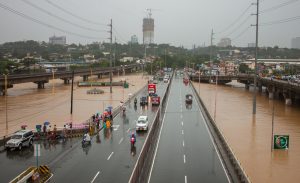The COVID-19 pandemic has impacted the way the disaster management sector prepares for and manages disasters. The past two years have demonstrated the need for far more strategic analysis, preparation, investment, and links to other sectors. Governments, humanitarian organizations, militaries, and the private sector across the Asia-Pacific need to re-think their strategies and transform their ways of working to be ready for future disasters and build a more resilient and prosperous region.
In Southeast Asia, ASEAN has committed to invest in new technologies and innovation to supplement traditional capacity building in disaster resilience. This is reflected in the ASEAN Vision 2025 on Disaster Management, ASEAN Agreement on Disaster Management and Emergency Response (AADMER) Work Program 2021-2025, and the Information and Communications Technology (ICT) Roadmap on Disaster Management for 2025 and Beyond. This commitment was profiled at the recent 2021 ASEAN Strategic Policy Dialogue on Disaster Management in August to improve efficiency and effectiveness in disaster management. But are these words turning into action?
ASEAN has facilitated cooperation and collaboration models but needs to further invest in and implement innovative solutions. Artificial Intelligence (AI), data analytics, drones, and space technology serve as enablers to strengthen capabilities to predict, prepare, prevent, and respond to disasters. As a first step, the ASEAN community has begun to “future proof” efforts by focusing on anticipatory humanitarian action and data governance, but there is still more to be done.
Developments in AI and predictive analytics make it possible to anticipate disasters. This facilitates a more proactive approach to enable delivery of more timely assistance to affected communities. In July 2020, predictive analytical frameworks implemented by the U.N. and other partner organizations forecasted severe flooding along the Jamuna River in Bangladesh. In response, OCHA’s Central Emergency Response Fund allocated and released funding of roughly $5.2 million. This enabled relief provision to those most in need before flooding reached critical levels. It was CERF’s fastest-ever disbursement of funds in a crisis.
ASEAN has signaled its move toward anticipatory humanitarian action utilizing similar predictive analytics tools. While predictive analytics has become more accurate, access to this information needs to trigger action. In Germany in 2021, early warning systems predicted and communicated the forthcoming floods, but authorities were slow to respond, and many affected communities were unaware of the flood risk or unwilling in significant numbers to act upon the early warning. This links back to the need to develop more comprehensive systems fit for purpose.
The COVID-19 pandemic illustrates that sector specific – health or disaster management – responses are insufficient. Typhoons and cyclones impacted the region during the pandemic. Preparedness for a disaster during a pandemic was lacking. Customs and excise delayed delivery of relief goods from overseas and social distancing measures limited the capacity of evacuation centers. Anticipatory humanitarian action necessitates that we plan from the future for multiple potential scenarios – from concurrent to simultaneous and complex disasters. This will require working across sectors to build more effective whole-of-society responses.
Technological developments allow for easier and faster data and information processing for anticipatory action from any sector. It is accompanied by an increased risk that sensitive information can fall into the wrong hands, harming those we want to help. The exceptional circumstances in which humanitarian actors operate do create context-specific data protection challenges, which need to ensure data protection principles are effective.
While Southeast Asian countries have national data and privacy laws, regional data protection and governance frameworks in ASEAN, particularly in a disaster setting, remain underdeveloped. In January 2021, the ASEAN Data Management Framework, ASEAN Model Contractual Clauses for Cross Border Data Flows, ASEAN CERT Information Exchange Mechanism, and the ASEAN Digital Masterplan 2025 were approved at the First ASEAN Digital Ministers’ Meeting. These initiatives include data governance structures and safeguards and are targeted at businesses and SMEs operating in the region.
The disaster management community can draw from these frameworks to build on their current commitments. It is well-placed to create a regional framework that addresses data protection and governance in disaster settings across all sectors as an anchor for anticipatory humanitarian action.
For this to happen, it is important for ASEAN to develop future-ready regional mechanisms and robust data governance alongside greater investment in digital education to build community capacity. Technological developments provide opportunities for the disaster management sector to lead in working with other sectors but alone they are not enough. ASEAN must ensure a people-centered ecosystem remains at the foundation of the regional community. This will lay the groundwork for technological developments to be harnessed and governed effectively to mitigate their associated risks. This will allow for a more robust regional system that places communities in the driving seat.
Ultimately ASEAN’s role is to facilitate greater interaction between countries and across sectors, at the subnational, national, regional, and international levels. It has facilitated the first step: recognizing opportunities for an improved system. Now it needs to be the catalyst for action across the region. This will provide the impetus for a future-ready system in Southeast Asia that ensures resilient communities can thrive in the years ahead.

































